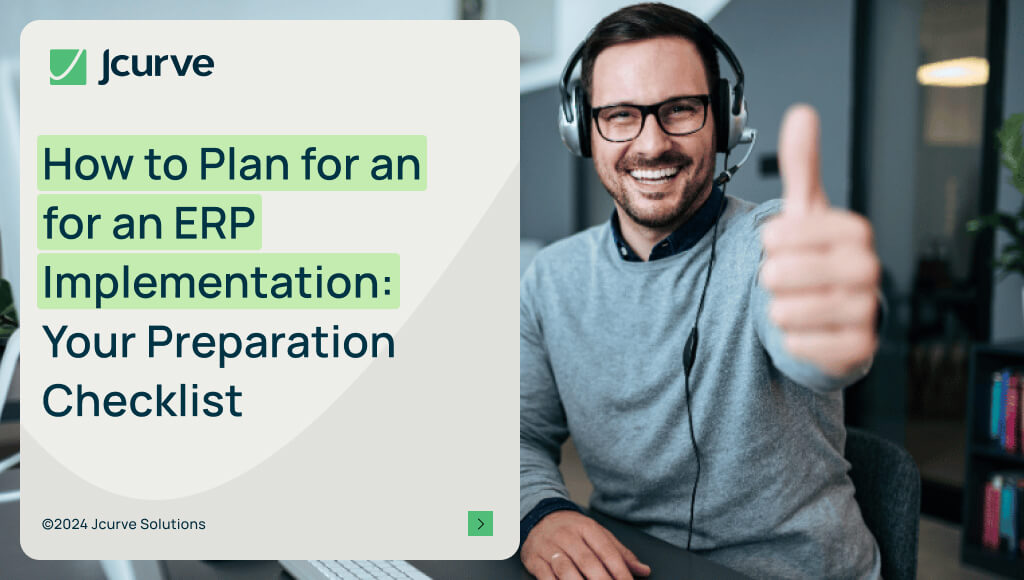
การย้ายบ้านเป็นเรื่องใหญ่และเป็นสิ่งที่คุณต้องเตรียมพร้อมล่วงหน้าก่อนวันย้าย การดำเนินการติดตั้ง ERP ก็ไม่แตกต่างจากนั้นมากนัก อาจมีหลายอย่างที่ต้องคิดถึง – ซึ่งเป็นเหตุผลที่การมีรายการตรวจสอบการเตรียมการสามารถช่วยให้คุณอยู่บนเส้นทางกับงานเตรียมการก่อนการดำเนินการที่สำคัญบางอย่างได้
บางทีคุณอาจยังอยู่ในขั้นตอน “เปิดบ้าน” ของการตรวจสอบระบบ ERP ที่ตอบสนองความต้องการของธุรกิจของคุณ หรือบางทีคุณอาจทำการวิจัยเสร็จสิ้นและเกือบพร้อมที่จะทำการย้าย ไม่ว่าคุณจะอยู่ในขั้นตอนใด จะมีการเตรียมการก่อนย้ายที่ต้องทำ
นี่คือบางส่วนของด้านสำคัญในการเตรียมพร้อมสำหรับการดำเนินการติดตั้ง ERP ที่สามารถช่วยสร้างรายการตรวจสอบการเตรียมการของคุณ
กระบวนการ
พูดคุยกับทีมของคุณเกี่ยวกับกระบวนการและการดำเนินงานประจำวันของพวกเขา กระบวนการใดที่ทำให้พวกเขาช้าลง? พวกเขาป้อนข้อมูลซ้ำแล้วซ้ำอีกและเพิ่มโอกาสของข้อผิดพลาดจากมนุษย์หรือไม่? มีความล่าช้าระหว่างขั้นตอนต่างๆ หรือไม่ เช่น ถ้าหนึ่งงานต้องพึ่งพางานก่อนหน้าที่ต้องเสร็จสิ้นก่อน? นี่คือประเภทของจุดอ่อนของกระบวนการที่คุณจะต้องการปรับปรุงเป็นส่วนหนึ่งของการดำเนินการติดตั้ง ERP ของคุณ
บริษัทหลายแห่งมีกระบวนการที่ไม่ได้รับการบันทึกไว้ และบางกระบวนการเหล่านี้ทำให้ธุรกิจช้าลง ตอนนี้คือโอกาสของคุณที่จะจับภาพสิ่งที่กำลังสร้างอุปสรรคและข้อผิดพลาดและบันทึกสถานะปัจจุบันและสถานะที่ต้องการ คุณจะได้รับเอกสารที่ทำให้คุณสามารถประเมินค่าของการปรับปรุงของคุณได้อย่างง่ายดาย บันทึกของคุณยังจะทำให้การฝึกอบรมพนักงานใหม่และดำเนินการปรับปรุงเพิ่มเติมในอนาคตเป็นเรื่องง่าย
ระบุสิ่งที่ทำให้ธุรกิจเสียเวลาและความพยายามก่อนเริ่มการดำเนินการติดตั้ง ERP ของคุณ มันจะช่วยให้คุณได้รับชัยชนะอย่างรวดเร็วและเพิ่มประโยชน์ในระยะยาว
บริษัทหลายแห่งมีกระบวนการที่ไม่ได้รับการบันทึกไว้ และบางกระบวนการเหล่านี้ทำให้ธุรกิจช้าลง ตอนนี้คือโอกาสของคุณที่จะจับภาพสิ่งที่กำลังสร้างอุปสรรคและข้อผิดพลาดและบันทึกสถานะปัจจุบันและสถานะที่ต้องการ
การรายงาน
ธุรกิจของคุณน่าจะมีชุดของรายงานที่ใช้เพื่อวัดผลการดำเนินงาน ไม่ว่าคุณจะส่งออกข้อมูลจากระบบหลายระบบและนำมารวมกันใน Excel หรือติดตามผลการดำเนินงานด้วยตนเอง ตอนนี้คือโอกาสของคุณที่จะทำให้การรายงานของคุณง่ายขึ้น
ระบบ ERP ใหม่ของคุณควรใช้ข้อมูลแหล่งเดียวและสร้างรายงานแบบเรียลไทม์ด้วยข้อมูลที่สมบูรณ์และอัปเดตล่าสุด การรอรายงานที่รวบรวมจากสเปรดชีตที่พึ่งพาสูตรที่ซับซ้อนควรจะไม่จำเป็นอีกต่อไปหากผู้ให้บริการโซลูชัน ERP ของคุณช่วยคุณใช้ประโยชน์สูงสุดจากซอฟต์แวร์ ERP ของคุณ
จดรายงานที่คุณใช้ในการติดตามผลการดำเนินงานปัจจุบันและทำงานร่วมกับผู้ให้บริการโซลูชันของคุณเพื่อกำหนดว่ารายงานใดจากในระบบ ERP ใหม่ของคุณจะให้ข้อมูลที่เท่าเทียมหรือดีขึ้น
การรอรายงานที่รวบรวมจากสเปรดชีตที่พึ่งพาสูตรที่ซับซ้อนควรจะไม่จำเป็นอีกต่อไปหากผู้ให้บริการโซลูชัน ERP ของคุณช่วยคุณใช้ประโยชน์สูงสุดจากซอฟต์แวร์ ERP ของคุณ
บทบาทและผู้ดูแลระบบ
โซลูชัน ERP บนคลาวด์หลายระบบมีพื้นฐานอยู่บนหลักการของบทบาทผู้ใช้งาน การทำงานกับบทบาทไม่เพียงแต่ให้ระดับความปลอดภัยเพิ่มเติม โดยรับประกันว่าผู้ใช้จะเห็นเฉพาะข้อมูลที่พวกเขาควรจะเห็นเท่านั้น แต่ยังช่วยให้การนำทางระบบสำหรับแต่ละผู้ใช้งานง่ายขึ้น
มอบหมายผู้ใช้หลัก
ระหว่างการดำเนินการติดตั้ง, ทีมของคุณจะเรียนรู้วิธีการใช้ระบบ ERP ใหม่ พวกเขาจะมีคำถามและต้องการคำตอบอย่างรวดเร็ว ผู้ใช้หลักภายในหรือผู้นำ ERP สามารถเพิ่มมูลค่าอย่างมากในกรณีนี้และช่วยให้ผู้อื่นมีการเปลี่ยนผ่านไปยังระบบใหม่อย่างราบรื่น
มักจะมีผู้ใช้บางคนที่เรียนรู้สิ่งใหม่ๆ ได้อย่างรวดเร็วและปรับตัวได้ง่าย; ผู้เรียนรู้โดยธรรมชาติ ดึงดูดผู้เรียนรู้เหล่านี้ตั้งแต่เนิ่นๆ และรับความช่วยเหลือจากพวกเขาในการเป็นบุคคลที่ “ไปหา” ระหว่างการดำเนินการติดตั้ง
มักจะมีผู้ใช้บางคนที่เรียนรู้สิ่งใหม่ได้อย่างรวดเร็วและปรับตัวได้ง่าย; ผู้เรียนรู้โดยธรรมชาติ ดึงดูดผู้เรียนรู้เหล่านี้ตั้งแต่เนิ่นๆ และรับความช่วยเหลือจากพวกเขาในการเป็นบุคคลที่ ‘ไปหา’ ระหว่างการดำเนินการติดตั้ง
การทำความสะอาดข้อมูล
หนึ่งในสิ่งที่เลวร้ายที่สุดที่คุณสามารถทำได้เมื่อดำเนินการติดตั้งระบบ ERP คือการย้ายข้อมูลที่ไม่ดีจากระบบที่มีอยู่มายังระบบใหม่ ซึ่งรวมถึงข้อมูลที่ซ้ำกัน ขาดหาย ไม่สมบูรณ์ และไม่ถูกต้อง
ERP ถูกออกแบบมาเพื่อขับเคลื่อนประสิทธิภาพกระบวนการและทำให้การดำเนินงานของคุณมีประสิทธิภาพมากขึ้น ดังนั้น การย้ายข้อมูลที่ไม่ดีจากระบบหนึ่งไปยังอีกระบบหนึ่งอาจทำให้เกิดปัญหาใหญ่
การทำความสะอาดข้อมูลไม่จำเป็นต้องหมายความว่าคุณต้องทำความสะอาดข้อมูลด้วยการค้นหาปัญหาอย่างละเอียดและใช้เวลามาก วิธีที่ง่ายกว่าคือการตัดสินใจว่าข้อมูลสำคัญใดที่ควรย้ายข้อมูลมาและตรวจสอบข้อมูลนั้น ข้อมูลที่ไม่สำคัญสามารถปล่อยไว้ในระบบเก่าหรือส่งออกไปเพื่อเก็บรักษาไว้เป็นบันทึก วิธีเหล่านี้สามารถให้จุดเริ่มต้นที่สะอาดและตรงไปตรงมา
พิจารณาข้อมูลที่คุณต้องการให้มีอยู่ในระบบ ERP ใหม่ของคุณ การโฟกัสที่ข้อมูลสำคัญสามารถช่วยเร่งกระบวนการดำเนินการติดตั้งโดยไม่ตัดทางลัดใดๆ
รายการตรวจสอบการเตรียมการของคุณ
ข้อที่ได้กล่าวไปแล้วสามารถช่วยสร้างรายการตรวจสอบการเตรียมการของคุณได้ การเก็บรายการตรวจสอบไว้ใกล้ตัวเพื่อติดตามทุกสิ่งที่ต้องทำก่อนเริ่มการดำเนินการติดตั้ง ERP เป็นความคิดที่ดี นี่คือสรุปอย่างรวดเร็ว:
- กระบวนการ – ระบุสิ่งที่ก่อให้เกิดอุปสรรคและข้อผิดพลาด และเริ่มบันทึกสถานะปัจจุบันและสถานะที่ต้องการของคุณ
- การรายงาน – เข้าใจรายงานที่คุณใช้ติดตามผลการดำเนินงานของธุรกิจและสิ่งที่จะถูกทำซ้ำหรือปรับปรุงในระบบ ERP ใหม่ของคุณ
- บทบาทและผู้ดูแลระบบ – กำหนดความต้องการตามบทบาทของผู้ใช้ระบบแต่ละคนและทำงานร่วมกับผู้ให้บริการโซลูชัน ERP ของคุณเพื่อเติมเต็มช่องว่างใดๆ
- ผู้ใช้หลัก – ดึงดูดพนักงานของคุณตั้งแต่เนิ่นๆ และรับความช่วยเหลือจากผู้เรียนรู้โดยธรรมชาติของคุณเพื่อเป็นจุดติดต่อภายในสำหรับความช่วยเหลือกับระบบ ERP ใหม่ของคุณ
- การทำความสะอาดข้อมูล – ตัดสินใจว่าข้อมูลใดที่จะทิ้งไว้ข้างหลัง ข้อมูลใดที่จะย้ายมา และโฟกัสที่การทำความสะอาดข้อมูลสำคัญของคุณ
เคล็ดลับพิเศษ: การใช้ประโยชน์จากความเชี่ยวชาญ
ไม่ว่าคุณจะอยู่ในขั้นตอน “เปิดบ้าน” ของซอฟต์แวร์ ERP ที่กำลังตรวจสอบระบบต่างๆ หรือพร้อมที่จะย้ายบ้าน ให้เริ่มคิดเกี่ยวกับการเตรียมพร้อมสำหรับการย้าย หากคุณต้องการความช่วยเหลือในการรวบรวมแผนการโจมตี ให้ถามผู้ให้บริการโซลูชัน ERP ที่มีประสบการณ์ซึ่งผ่านกระบวนการนี้มาหลายครั้งก่อน
ผู้ให้บริการ ERP ของคุณสามารถเป็นทรัพยากรที่มีค่าได้ ดังนั้นอย่าลืมใช้ประโยชน์จากความเชี่ยวชาญของพวกเขา พวกเขาสามารถให้คำแนะนำที่จำเป็นเพื่อทำให้การดำเนินการติดตั้ง ERP ของคุณเป็นการย้ายที่เป็นบวก เพื่อให้ทุกอย่างถูกต้องตั้งแต่ครั้งแรก และช่วยให้คุณเห็นผลตอบแทนจากการลงทุนได้เร็วยิ่งขึ้น

Jessica has a Bachelor of Arts degree from Trent University and a Masters degree from Cambridge University. He is an Adjunct Professor of Finance at Simon Fraser University’s Beedie School of Business and is both a Canadian Chartered Professional Accountant and a UK Chartered Accountant.

Jessica has a Bachelor of Arts degree from Trent University and a Masters degree from Cambridge University. He is an Adjunct Professor of Finance at Simon Fraser University’s Beedie School of Business and is both a Canadian Chartered Professional Accountant and a UK Chartered Accountant.





